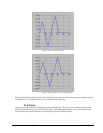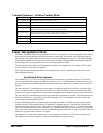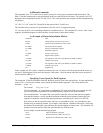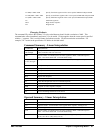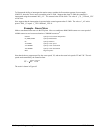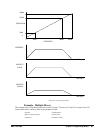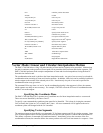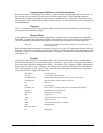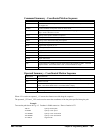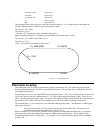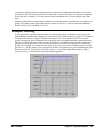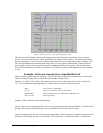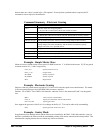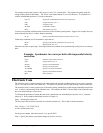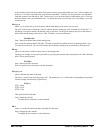
102 • Chapter 6 Programming Motion DMC-1700/1800
Compensating for Differences in Encoder Resolution:
By default, the DMC-1700/1800 uses a scale factor of 1:1 for the encoder resolution when used in vector mode. If
this is not the case, the command, ES can be used to scale the encoder counts. The ES command accepts two
arguments which represent the number of counts for the two encoders used for vector motion. The smaller ratio of
the two numbers will be multiplied by the higher resolution encoder. For more information, see ES command in the
Command Reference.
Trippoints:
The AV n command is the After Vector trippoint, which waits for the vector relative distance of n to occur before
executing the next command in a program.
Tangent Motion:
Several applications, such as cutting, require a third axis (i.e. a knife blade), to remain tangent to the coordinated
motion path. To handle these applications, the DMC-1700/1800 allows one axis to be specified as the tangent axis.
The VM command provides parameter specifications for describing the coordinated axes and the tangent axis.
VM m,n,p
m,n specifies coordinated axes p specifies tangent axis such as X,Y,Z,W p=N
turns off tangent axis
Before the tangent mode can operate, it is necessary to assign an axis via the VM command and define its offset and
scale factor via the TN m,n command. m defines the scale factor in counts/degree and n defines the tangent position
that equals zero degrees in the coordinated motion plane. The operand _TN can be used to return the initial position
of the tangent axis.
Example:
Assume an XY table with the Z-axis controlling a knife. The Z-axis has a 2000 quad counts/rev encoder and has
been initialized after power-up to point the knife in the +Y direction. A 180° circular cut is desired, with a radius of
3000, center at the origin and a starting point at (3000,0). The motion is CCW, ending at (-3000,0). Note that the 0°
position in the XY plane is in the +X direction. This corresponds to the position -500 in the Z-axis, and defines the
offset. The motion has two parts. First, X,Y and Z are driven to the starting point, and later, the cut is performed.
Assume that the knife is engaged with output bit 0.
#EXAMPLE Example program
VM XYZ XY coordinate with Z as tangent
TN 2000/360,-500 2000/360 counts/degree, position -500 is 0 degrees in XY plane
CR 3000,0,180 3000 count radius, start at 0 and go to 180 CCW
VE End vector
CB0 Disengage knife
PA 3000,0,_TN Move X and Y to starting position, move Z to initial tangent position
BG XYZ Start the move to get into position
AM XYZ When the move is complete
SB0 Engage knife
WT50 Wait 50 msec for the knife to engage
BGS Do the circular cut
AMS After the coordinated move is complete
CB0 Disengage knife
MG “ALL DONE”
EN End program



